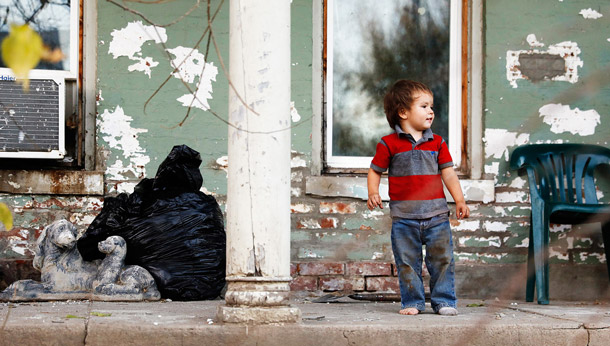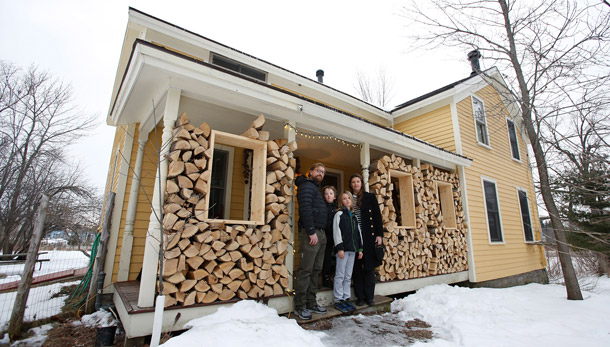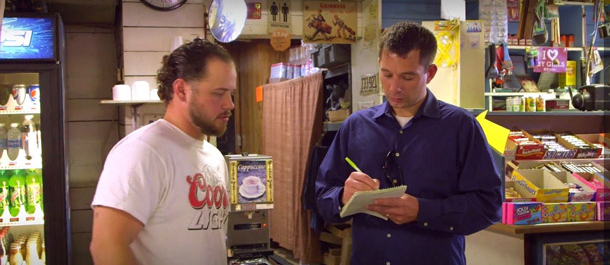Thousands of Lead-Poisoned Communities
Air Date: Week of December 15, 2017

St. Joseph, Missouri, has neighborhoods filled with aged homes and high rates of lead poisoning. Here, Kadin Mignery, 2, plays on his front porch. Kadin was diagnosed with lead poisoning, prompting his mother to change his diet and repaint the home’s interior. (Photo: courtesy of REUTERS/Whitney Curtis)
Flint, Michigan became a flashpoint for excess blood lead levels in children, putting their brains and social development at risk. Now a data based investigation by Reuters reporters Michael Pell and Joshua Schneyer has found over 3,800 neighborhoods around the country with children with blood levels of the toxic metal double those in Flint. Michael Pell tells host Steve Curwood where and for whom the risk is greatest.
Transcript
CURWOOD: From PRI, and the Jennifer and Ted Stanley Studios at the University of Massachusetts, Boston, this is Living on Earth. I’m Steve Curwood. Homicide. That’s the charge in the form of involuntary manslaughter that five Michigan officials are still facing in connection with the Flint lead poisoning scandal that began back in 2014. But apparently Flint is hardly unusual when it comes to lead poisoning, which can stunt the brain development of children and increase their vulnerability to school failure, delinquency and crime. We now know there are close to 4,000 other places in America where children have blood lead levels more than double those found at Flint, thanks to an investigation by Reuters. And the problem is not just with lead pipes and contaminated water, as in Flint, but also from buildings and soil. Michael Pell is part of the Reuters reporting team, and he joins us now. Welcome to Living on Earth.
PELL: Thanks for having me.
CURWOOD: How did this investigation get going?
PELL: So, after the Flint issue rose up a couple of years ago now, my reporting partner and I, Joshua Schneyer, started wondering what other communities had problems with childhood lead poisoning. I mean, was Flint the only city left in the United States that had this problem, or were there other communities that were also suffering? So, we set out to identify other Flints across the country.
CURWOOD: So, tell me about what you found. What do you have in this latest data report that you put together for Reuters?
PELL: So, what we found was that Flint was not the only community that was suffering from this pro blem, but there were hundreds of communities across the country that are suffering with childhood lead exposure, and what we wanted to do was find these neighborhoods that had not enjoyed the same success that other communities had, and to do that we needed to obtain data that would show at a granular level where kids were getting exposed. Previously, the only information available to the public was that these countywide maps that states made to show the percentage of tested kids in the county that had high lead levels, and what we found was that those countywide maps not only didn't really show the problem areas, but they actually could provide a false sense of security. Because if you look at the entire county, OK, sure, there's a small percentage of kids with high lead levels, but if you break that down by neighborhood level what you could see is that there are some neighborhoods where a lot of kids are still testing very high for lead.

Residents in Orleans, New York, are concerned about high levels of lead in their water. Andy Greene (left) and Stephanie Weiss (right), with their children Sam (2nd left) and Leo outside their home, are among community organizers pushing for clean water. (Photo: courtesy of REUTERS/Chris Wattie)
And so, what we did was obtain data broken down by census tract or zip code from the states to identify these neighborhoods where kids still had high lead levels. And this was inspired by a story we wrote in East Chicago, Indiana. And in East Chicago there was this one housing development that was built on top of an old smelting site, an old industrial site, and the CDC study said there was virtually no chance of children being exposed to lead from that old site, and of course, then a few years later the mayor was evacuating this housing community. And we went back and took a look at the state's data and showed that the CDC's assessment was incorrect. The CDC claimed correctly that while the city as a whole had a low percentage of children testing high for lead, in the census tract where that housing development was located, there was a very high percentage of kids with elevated lead levels.
CURWOOD: So, where did you get your data for this project?
PELL: We have taken the data directly from state health departments and from the CDC. Many states provided the data very quickly, other states really dragged their feet and decided that they didn't want this information out there. States like Ohio, for example. And so what we had to do is go to the CDC and issue FOIA requests to them for the same data because in many cases the states report their blood lead levels results to the CDC.
CURWOOD: Now, you are building on some previous data. What are the changes or additions that you saw since you started this project?
PELL: Sure, so what we've done is publish stories as the data comes in, and the most recent data that we obtained was from the CDC for New York City, Georgia, Tennessee, Kansas, and this has brought the total number of neighborhood areas with the percentage of tested children with elevated lead levels to double the level of Flint during the peak of that city's crisis to 3,800.
CURWOOD: Wow. So, in your research, Michael, what did folks tell you are typically the major sources of lead poisoning in children? Flint, we know was water, but what else do they say?
PELL: Well, so even in Flint it's commonly perceived that it's water, but there are kids that had high lead exposure before the problems with the water, and it's a tricky situation because a lot of people, a lot of public health experts don't believe water contributes significantly to a child's lead levels. Although in Flint, in Washington DC, and other communities we have seen that when there are problems with the water system, the number of children with elevated lead levels increases. So, it's extraordinarily difficult to determine what the sources are. What the data tells you is that where the lead ends up, and that's in the blood of children. Typically, experts believe that the major source of lead exposure comes from old, decaying paint, but I think that more and more research is being done to determine exactly where lead exposure is coming from and a lot of people are starting to think that maybe it is a cumulative effect – lead paint still being probably the driving factor, but that old lead plumbing fixtures also contribute, soil in people's yards. When that lead paint comes off their houses, when the exhaust that contains lead in the past from car fumes, that gets into the soil and that doesn't go anywhere and so when you go outside, you play, kids stick their hands in their mouth, you track the dirt back inside your house, they're playing on the ground, that gets into a child's blood system as well.
CURWOOD: Talk to me about demographics here. To what extent do you see these exposures in lower income communities, communities of color, and that sort of thing?
PELL: Yeah, I think if you look at the map that we published you can see that these communities are often low-income neighborhoods, often neighborhoods, predominately people of color. You know places like Cleveland, Baltimore, Philadelphia. High percentages of kids there are testing high. On the other hand, sometimes when you look at the map you find communities that don't fit that profile. In New York, for example, we identified the neighborhood with the highest percentage of tested kids with elevated lead levels in southern Williamsburg, and this is traditionally Hasidic neighborhood, and so it varies by community.
CURWOOD: Talk to me about the affected areas and what relationship if any there are among them?
PELL: Well, typically it's older housing, older housing that's poorly taken care of. And so, back to your question. These are often communities of color, these are often low socio-economic communities that are disproportionately affected by lead, but what we're also seeing is that gentrifying neighborhoods are also being affected. People move into these old houses, these historic homes, homes that have been painted for decades, if not 100 years with lead paint and they come in and they start renovating and that can kick up a lot of this old lead paint. What we also see is the communities that have a long industrial history. One census tract that we identified in Indiana, it doesn't have a tremendous amount of older housing, but what it did have was a lead smelter site in it, and there was a housing development built on top of that.
CURWOOD: So, in the course of this research you must have visited some interesting, and I imagine, alarming places. Give me your top five communities that you think are really in trouble from lead, if you're in a position to do so.

Antonin Bohac, a mechanic at the Brushy Creek Mine, a lead mine, discusses lead exposure with reporter Michael Pell. Mr. Bohac was diagnosed with high lead levels. (Photo: courtesy of REUTERS/Mike Wood)
PELL: Yeah, I mean top five, it would be very subjective here, but Buffalo, New York, has the perfect confluence of events. It's got a lot of poverty, it's got a tremendous amount of old housing, and we saw extremely high percentages of tested children there with elevated lead levels. In South Bend, Indiana, my reporting partner Joshua Schneyer visited that community and immediately found families that were dealing with this problem. They had almost run out of funding to conduct testing in this community, but after we published our report, the University of Notre Dame and the city stepped in to get more funding to test kids, and right now are working to identify lead exposures in homes there. Philadelphia, Pennsylvania, has a terrible problem. All throughout Pennsylvania, really, there are communities that are suffering with this and we were talking to the leaders of the health department in York, Pennsylvania, and they feel like they're trying their best, but every year their resources seem to dwindle, and it almost feels like they're overwhelmed by this problem, they don't know exactly what they can do to get a handle on this.
CURWOOD: What do you think are the social and economic and political costs of all this lead contamination in our environment?
PELL: Well, I've spent almost two years now talking to epidemiologists, public health experts, people that run nonprofits to provide healthy housing for people, and I think ultimately what we can safely say is that we know lead is a problem. I mean, there's no safe amount of lead in a child's blood system and that there are costs down the road for society as a whole. Lead causes permanent learning disabilities in children, it can cause behavioral problems, so that problem is not going to go away until we focus more attention on it, and we're trying to provide information for organizations like green and healthy housing to identify communities that are in the most need. So, that way they can in the future, instead of having to spend money on behavioral services for children with learning disabilities, they can instead provide additional education resources that take children to the next step.
CURWOOD: Michael, there's been research done by folks in Cincinnati at that university and medical facility, also in Pittsburgh, also in Boston and Harvard, research that shows a link between childhood lead exposure and crime. What do you make of that research and what does all this lead in our environment say in terms of crime and delinquency and public safety?
PELL: There's been a lot of research that has linked lead poisoning to crime. The behavioral problems that I was discussing and the inability to control impulses has been linked directly to lead poisoning. Exactly how much that costs and what the direct link is is not absolutely perfect, but I think that there's enough smoke there that it suggests that there is a correlation. You know, in Baltimore, Freddy Gray, who was famously killed after an encounter with police, he had childhood lead exposure, and he had a history of run-ins with the police. The lead poisoning was probably one factor, and that's one factor that can be removed, you know, whatever else was going on in his life, it is possible to provide healthy, safe housing for people, and I think that there will continue to be research done showing that lead is a pervasive societal problem, both in terms of learning disabilities, in terms of its link to social unrest and hopefully the way that that's most conclusively proven is as housing becomes safer, as we provide better environments for children, the amount of crime in those neighborhoods will continue to drop, and the success in school will continue to increase.

Michael Pell is a reporter for Reuters who has been covering national childhood blood lead levels for years. (Photo: courtesy of Michael Pell)
CURWOOD: So, what plans are there to release these data widely and how are you going to do that?
PELL: So, after we published our first story we got a tremendous response from researchers, epidemiologists, other reporters who wanted to use this data, and we are now working on making the raw data that we received from states, from the CDC, available in a downloadable form. So you'll be able to go up and download an individual state or download data for every state that we received. And we hope that researchers will use this data to answer some of the tough questions that you asked today that, quite frankly, maybe we're just not smart enough to do. Questions about how does lead poisoning affect communities of color? How should public funding be used to identify children with lead poisoning and to identify where the communities that need this help the most?
CURWOOD: In what ways has your reporting prompted cities, towns, localities to act?
PELL: That's been one the most gratifying things about this project is that we have seen a tremendous amount of concrete action on the ground. The state of California just last month passed legislation that will hopefully get more children across the state tested for lead poisoning, and the author of that bill cited our reporting as playing a role and prompting him to do this. In South Bend, Indiana, the University of Notre Dame, started a course, a chemistry-in-the-community type course, to go out and actually test children for lead poisoning. We've talked to public health officials in northern California that are trying to pass a law right now that would require more inspections of older housing.
The other thing that we've seen is that by providing this data, by letting people know that it's out there, we've seen other local media start to pick this up as well, and I'd love to see communities that have problems in Pennsylvania and Michigan and Ohio, some of these states, I'd like to see the media there continue to report on this every year, make it kind of an annual story when the local blood lead level data comes out, they do a story on it to keep the pressure on public health officials.
CURWOOD: Michael Pell is a reporter with Reuters. Thank you so much, Michael.
PELL: Thanks for having me, Steve. I really appreciate it.
Links
Reuters: “Reuters finds 3,810 U.S. areas with lead poisoning double Flint’s”
Reuters: “Special Report: Thousands of U.S. areas afflicted with lead poisoning beyond Flint’s”
CNN: Timeline of events in Flint, Michigan during the city’s water crisis
Living on Earth wants to hear from you!
Living on Earth
62 Calef Highway, Suite 212
Lee, NH 03861
Telephone: 617-287-4121
E-mail: comments@loe.org
Newsletter [Click here]
Donate to Living on Earth!
Living on Earth is an independent media program and relies entirely on contributions from listeners and institutions supporting public service. Please donate now to preserve an independent environmental voice.
NewsletterLiving on Earth offers a weekly delivery of the show's rundown to your mailbox. Sign up for our newsletter today!
 Sailors For The Sea: Be the change you want to sea.
Sailors For The Sea: Be the change you want to sea.
 The Grantham Foundation for the Protection of the Environment: Committed to protecting and improving the health of the global environment.
The Grantham Foundation for the Protection of the Environment: Committed to protecting and improving the health of the global environment.
 Contribute to Living on Earth and receive, as our gift to you, an archival print of one of Mark Seth Lender's extraordinary wildlife photographs. Follow the link to see Mark's current collection of photographs.
Contribute to Living on Earth and receive, as our gift to you, an archival print of one of Mark Seth Lender's extraordinary wildlife photographs. Follow the link to see Mark's current collection of photographs.
 Buy a signed copy of Mark Seth Lender's book Smeagull the Seagull & support Living on Earth
Buy a signed copy of Mark Seth Lender's book Smeagull the Seagull & support Living on Earth

